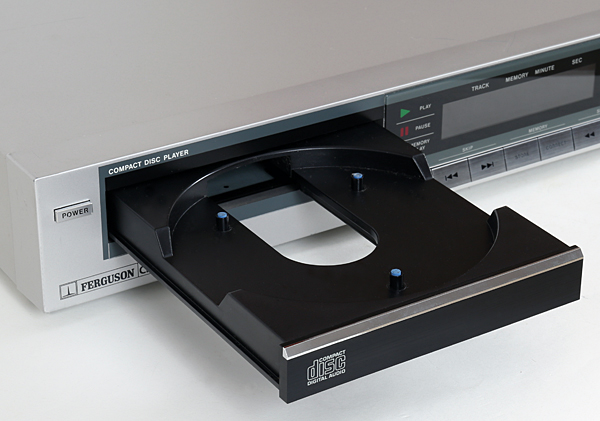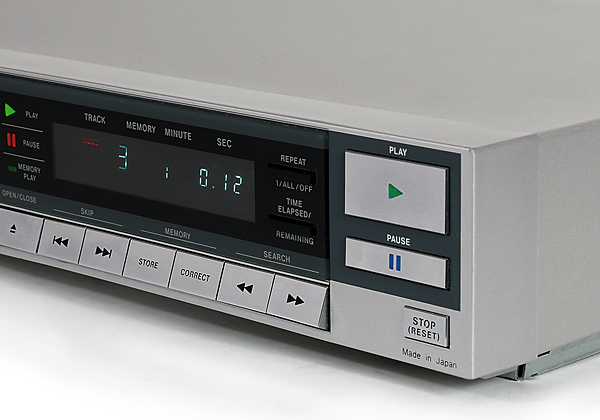Ferguson CD 03 CD player

 This slimline design was fashioned with Yuppies in mind yet packed tried-and-tested tech from premium Sony products. How does it shape up today? It's time to find out
This slimline design was fashioned with Yuppies in mind yet packed tried-and-tested tech from premium Sony products. How does it shape up today? It's time to find out
When it comes to CD players, Ferguson has a claim to fame, for its CD 01 [HFN Jan '19] of 1984 was the first machine to appear from a British household name. The player's Sony origins also meant it stood out from the crowd. At the time, manufacturers wishing to gain a foothold in the rapidly growing market for CD players, but who lacked the R&D resources to build machines of their own, usually went to Philips for the hardware. Sony's players were considered to be top of the market, the Japanese company's carefully cultivated image only helping to justify their premium prices.

Lifestyle Choice
Although the CD 01 made no lasting impression on UK audiophiles, Sony continued to cooperate with Ferguson, providing the basis for the CD 02 that followed and the CD 03 seen here. The CD 02 was based on the Sony CDP-102, a highly specified machine which, in Sony livery at least, sold well in the UK. The CD 03 of 1985 was smaller and neater, mirroring perfectly the idea that the CD was now part of the uncluttered, stylish lifestyle to which the 'upwardly mobile' members of mid '80s society aspired.
Sony never attempted to court the market for 'your name here' players, as Philips and Hitachi had done in Europe and Japan respectively. However, the basic design behind the CD 03 could be found in a wide range of models. The direct Sony equivalent was the CDP-33, sold mainly on the home market in Japan. The more widely exported CDP-30 was technically almost identical, although its fascia design and mix of facilities were slightly different. This model was available in the UK, but it tended to be offered as part of Sony's top-line 'Compact' packaged systems. Perhaps the variant that sold in the greatest numbers in the UK was the Aiwa DX-770. Aiwa had been under the control of Sony since the late '60s but design autonomy had been maintained, allowing, for example, Aiwa to outpace Sony in terms of cassette deck technology for most of the 1970s.


Tiny Chips
Aiwa's first two CD players had been completely independent designs with almost no Sony content whatsoever. Key parts like optical units, servo motors and the main circuit elements were all either produced in-house or sourced from the likes of Yamaha and Burr-Brown. However, the internal rationalisation that became a necessary part of corporate Japan at around this time forced Aiwa finally to accept a Sony product as its own, although a unique fascia and colour scheme was devised to hide the fact.
Technically, all these machines employed a mixture of existing and new ideas. A simply constructed mechanism held a Sony KSS121A optical block along with an inexpensive DC brush-type motor for the disc spindle. Both these items took up much less space inside the player's cabinet than did their counterparts in the earlier models. The laser tracked the disc on a sled mechanism that was driven along by another DC brush-type motor through a rack and pinion arrangement. In this respect the Ferguson CD 03 differed from the company's more elaborate CD 02, which used a fast-access linear motor for this purpose.

The CD 03's servo, error correction and decoding functions were all performed by chips taken from Sony's D-50 portable player [HFN Jan '13] and not one of its full-sized machines. These tiny, surface-mounted components meant that it was now easy to get all the important parts of the player onto a single printed circuit board, increasing reliability and reducing production costs. One full-sized item that was carried over was the CX20017 DAC, an old favourite since the days of Sony's debut player, the CDP-101 [HFN Jan '12].
Classic Layout
Although some of the more upmarket Sony models now boasted separate DAC chips for each channel, the CDP-33, Ferguson CD 03 and Aiwa DX-770 struggled on with one non-oversampled chip, time-shared between left and right channels. Smoothing, and alias rejection, was achieved with high-slope, low-pass analogue filters that bit steeply beyond 20kHz. While an effective option for use in simple players, the days of this classic layout were numbered. The cost of DAC chips was falling just as the format's 'wow' factor was on the wane and so traditional 'number war' tactics were beginning to be used to help sell players to the public.
Perhaps the most striking thing about the CD 03 is how small it is. CD players built for use in hi-fi systems have always been about the same size. Indeed, even though great progress has been made in the miniaturisation of electronics since the introduction of the format, few designers appear to have been keen to exploit the possibilities this brings.
Still, the CD 03 is deceptive. It actually has the same proportions as a conventional player but is smaller in every dimension, so despite its rather bland and derivative layout it is an attractive little unit. And while the 'Stop' key is labelled 'Reset', giving away the player's Sony origins, otherwise this compact machine is fairly conventional in terms of its ergonomics.
Sony Slickness
When it comes to using the CD 03, as with the CD 01, the display can prove somewhat confusing when a disc is first loaded. After the TOC is read, the display shows '0', making one think that the disc has not been read successfully. This is normal though, and a track number appears as soon as playback starts.























































